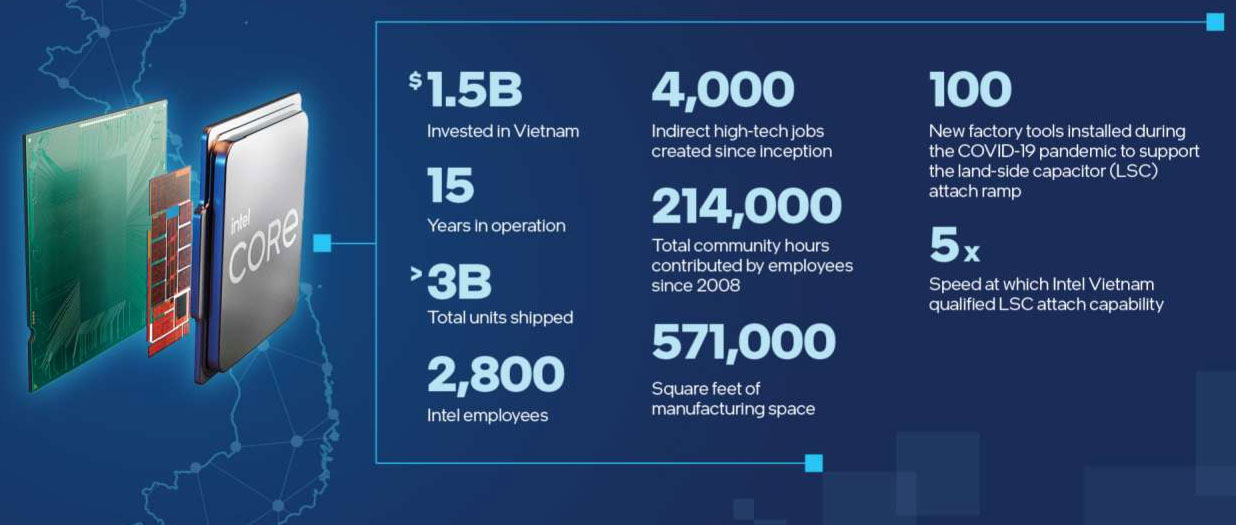Intel's Innovative Substrate Shortage Solution Made It $2 Billion in 2021
Intel's vertical integration made it more resilient to supply pressures.
Intel's Vietnam Assembly and Test (VNAT) factory implemented a critical change last year. An "innovative approach to substrate processing" in Vietnam enabled Intel to produce millions of additional products, while competitors were squeezed by supply constraints. The effect on the balance sheet has been impressive. It is estimated that VNAT was responsible for over $2 billion in revenue upside for Intel, helping the company better meet customer demand during a difficult period.
This week, Intel thanked everyone at its Vietnam site for their contributions and credited the success to its vertically integrated business model.
The key change made at VNAT was to set aside some factory floor space to attach all the required capacitors to chip substrate material. An investment was made to buy and train on machinery required for this preparatory but essential step to making finished computer chips.
Previously, chip substrate arrived at Intel's chipmaking factory with capacitors placed ready on one side by the supplier. Intel would then place the capacitors on the other side and use the substrate for the processor. Please also understand that different products require different capacitors in different locations on the substrate. Thus Intel would have to order a quantity of substrate for Chip A, B, C and so on – and it wouldn't be able to chop and change between substrates if it ran out of one or another.
VNAT geared up to take in the substrate that hadn't been processed by the supplier, with no capacitors in place. This reduced a significant processing burden from suppliers, making it easier for Intel to acquire substrates and be flexible with the stock it took in. "By bringing this capability in-house, we are able to complete chip assembly more than 80% faster, while at the same time freeing up the substrate suppliers who are constrained on capacity," noted VP and GM of Intel Products Vietnam, Kim Huat Ooi. Intel's blog post doesn't specifically mention any cost savings on its substrate acquisitions, but it must have enjoyed a saving on this, as it would save the supplier time/money and incur an in-house cost.
Intel's in-house processing of both sides of the substrates began in May 2021, and the team responsible for this process is satisfied that they have already created a scalable manufacturing process that "matches that of our substrate suppliers" in quality terms.
The upshot of VNAT doing all the capacitor placements on substrates in-house was that it "enabled millions of additional units amid supply constraints," claims Intel. Judging from the timings stated above, these benefits were likely seen first with the launch of Alder Lake chips.
Get Tom's Hardware's best news and in-depth reviews, straight to your inbox.
Intel's success throws its approach into contrast with the difficulties facing chip companies like AMD and Nvidia which have less vertically integrated businesses. The red and green teams don't have chipmaking factories to reconfigure if they see any opportunities for efficiency gains or cost savings. However, they also don't worry about owning hugely expensive to build (and maintain) production facilities.
During the last year, with pandemic-related shortages, Intel purportedly gained $2 billion of revenue thanks to its level of business integration and the new in-house substrate processing. But, with the cyclical nature of the semiconductor business, those big chipmaking plants may be a drain on Intel's business in the not-too-distant future. When we move from shortage to oversupply, semiconductor fab margins can fall precipitously. Some business leaders and analysts think the global chip shortage will end soon, while others reckon it could be 2024 or later. However, no one believes that it will last forever.

Mark Tyson is a news editor at Tom's Hardware. He enjoys covering the full breadth of PC tech; from business and semiconductor design to products approaching the edge of reason.
-
jkflipflop98 There's going to be another MASSIVE chip shortage once China takes Taiwan. Even if they manage to capture TSMC's main facilities intact and get everyone to work there as if nothing has ever happened and it's business as usual, China will be sanctioned and embargo'd so heavily it won't be able to buy equipment or sell chips.Reply
China has watched carefully as the world takes a hands-off "too big to fight" stance with Russia. I'm sure China knows they're also "too big to fight". -
maik80 Reply
There is no way to embargo China, the world's factory and practically the world's biggest economy, the latest attempt by the US only hurt the US economy, while China grew by 8%.jkflipflop98 said:There's going to be another MASSIVE chip shortage once China takes Taiwan. Even if they manage to capture TSMC's main facilities intact and get everyone to work there as if nothing has ever happened and it's business as usual, China will be sanctioned and embargo'd so heavily it won't be able to buy equipment or sell chips.
China has watched carefully as the world takes a hands-off "too big to fight" stance with Russia. I'm sure China knows they're also "too big to fight".
The US strength in the globalized market is weak, Russia, for example, continues to trade and receive goods from China, by ship, by train, and what can the US do? Fighting both, NATO has already shown that it has no military capability without American support, and Turkey that it has is much more allied with Russia and China.
And Russia is not using anything in Ukraine, of the fleet of fighters of more than 2 thousand they have used so far 180, between fighters and bombers, of the tanks that exceed 6 thousand they have used and are using 500, in the vast majority old t72 and t80, Ukraine has records of only 5 t90 and 10 terminators. It's as if Russia wants to stall the war so that NATO enters and the real war happens. And according to an EU minister, the aid provided so far to Ukraine has already depleted NATO's military stockpiles. -
rluker5 Vietnam plant getting it done!Reply
Sometimes you just have to take those lemons and make lemonade. -
Co BIY This is one advantage of enormous size and controlling multiple parts of the process. More sources for innovative ideas that can be rapidly implemented across the organization.Reply -
Krotow Replymaik80 said:There is no way to embargo China, the world's factory and practically the world's biggest economy, the latest attempt by the US only hurt the US economy, while China grew by 8%.
The US strength in the globalized market is weak, Russia, for example, continues to trade and receive goods from China, by ship, by train, and what can the US do? Fighting both, NATO has already shown that it has no military capability without American support, and Turkey that it has is much more allied with Russia and China.
And Russia is not using anything in Ukraine, of the fleet of fighters of more than 2 thousand they have used so far 180, between fighters and bombers, of the tanks that exceed 6 thousand they have used and are using 500, in the vast majority old t72 and t80, Ukraine has records of only 5 t90 and 10 terminators. It's as if Russia wants to stall the war so that NATO enters and the real war happens. And according to an EU minister, the aid provided so far to Ukraine has already depleted NATO's military stockpiles.
Russian and China military stockpiles doesn't appear from thin air too. Also Russian military besides high tech weaponry shortage due to sactions now begin to face serious manpower shortage. China however will not go into war with US and NATO not now and not after 5 years. More likely Xi will go bust in CCP People's Congress at end of year. And his successor will prefer trade over muscle flexing and soft power which always worked for China just fine. So stop dreaming. -
maik80 Reply
China is building the largest naval fleet and the largest amphibious invasion fleet for nothing. The US doesn't scare anyone even more with missiles capable of sinking aircraft carriersKrotow said:Russian and China military stockpiles doesn't appear from thin air too. Also Russian military besides high tech weaponry shortage due to sactions now begin to face serious manpower shortage. China however will not go into war with US and NATO not now and not after 5 years. More likely Xi will go bust in CCP People's Congress at end of year. And his successor will prefer trade over muscle flexing and soft power which always worked for China just fine. So stop dreaming. -
edzieba Reply
Russia have lost more than 700 tanks already, let alone "only 500 used": https://www.oryxspioenkop.com/2022/02/attack-on-europe-documenting-equipment.html They have deployed a not insignificant proportion of their active materiel.maik80 said:And Russia is not using anything in Ukraine, of the fleet of fighters of more than 2 thousand they have used so far 180, between fighters and bombers, of the tanks that exceed 6 thousand they have used and are using 500, in the vast majority old t72 and t80, Ukraine has records of only 5 t90 and 10 terminators. It's as if Russia wants to stall the war so that NATO enters and the real war happens. And according to an EU minister, the aid provided so far to Ukraine has already depleted NATO's military stockpiles.
NATO supplies to Ukraine have been relatively limited, mostly due to issues of compatibility (e.g. NATO have stockpiles of 5.56 NATO and 7.62 NATO ammunition, Ukraine primarily equipped with 7.62 Soviet, so arms and ammunition needed to be supplied as a package deal complicating logistics) and training (knowing how to operate an S300 system does not translate into knowing how to operate a Patriot system) due to complexity of modern weapon systems. Self-contained man-portable systems have thus been the most exported (such as the NLAW), as they have minimal logistical backhaul to support them and training can be very rapid. Second are export of legacy systems that are already in use in Ukraine but had been retained by NATO countries with a mix of NATO and ex-Warsaw Pack equipment such as Poland. Export of updated NATO systems will take time as Ukraine personnel are trained up on their use. This is obvious in the case of aircraft, but modern armoured vehicles, artillery systems, etc are of much higher complexity than even a few decades ago due to their networked nature.
